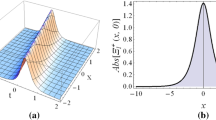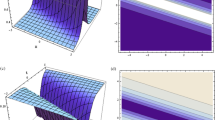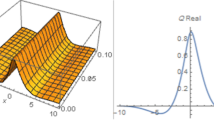Abstract
This paper studies the optical soliton solutions of the Biswas–Arshed equation with the help of two different techniques, such as the generalised exponential rational function (GERF) technique and Kudryashov’s simplest equation technique. The GERF technique extracts distinct families of exact solitary wave solutions involving trigonometric function solutions, hyperbolic function solutions, rational function solutions, etc. After that, we apply Kudryashov’s simplest equation method in the context of Bernoulli and Riccati equations to attain different kinds of families of exact soliton solutions. All the acquired solutions of the equation have numerous applications in many branches of nonlinear sciences such as plasma physics, superconductivity, nonlinear optics, biophysics, star formation, quantum mechanics, etc. and many more connected fields of nonlinear wave sciences. The exact solitary wave solutions obtained by GERF technique and Kudryashov’s simplest equation technique are in more generalised form as they contained several arbitrary parameters. Subsequently, to understand the behaviour of deduced solutions, we graphically discuss the real part, imaginary part and modulus of these solutions by suitable choice of involved arbitrary parameters.










Similar content being viewed by others
References
B Ghanbari, H Günerhan and H M Srivastava, Chaos Solitons Fractals 138, 109901 (2020)
S K Dhiman, S Kumar and H Kharbanda, Mod. Phys. Lett. B 35(34), 2150528 (2021)
S Kumar, S K Dhiman, S Kumar and A Chauhan, Math. Comput. Simul. 196 319 (2022)
S Kumar, Pramana – J. Phys. 95, 1 (2021)
S Kumar and M Niwas, Pramana – J. Phys. 95, 1 (2021)
S Kumar and N Mann, J. Ocean Eng. Sci., https://doi.org/10.1016/j.joes.2022.04.007(2022)
A J M Jawad, Stud. Math. Sci. 5(2), 13 (2012)
Sirendaoreji, Nonlinear Dynam. 89(1), 333 (2017)
E M E Zayed and K A E Alurrfi, Optik 127(20), 9131 (2016)
M Niwas, S Kumar and H Kharbanda, J. Ocean Eng. Sci., https://doi.org/10.1016/j.joes.2021.08.002(2021)
S Kumar, K S Nasar and A Kumar, Results Phys. 28(5), 104621 (2021)
Z Pinar, H Rezazadeh and M Eslami, Opt. Quantum Electron. 52, 504 (2020)
M Ekici, A Sonmezoglu, Q Zhou, S P Moshokoa, M Z Ullah, A H Arnous and M Belic, Opt. Quantum Electron. 50(2), 75 (2018)
F Ali, E Mehmet and S Abdullah, The Sci. World J. 2014, 534063 (2014)
M Foroutan, J Manafian and A Ranjbaran, Optik 162, 86 (2018)
M Foroutan, J Manafian and I Zamanpour, Optik 164, 371 (2018)
H Günerhan, Hindawi Math. Probl. Eng. 2020, 5926836 (2020)
A Biswas and S Arshed, Optik 174, 452 (2018)
AI Aliyu, M Inc, A Yusuf, D Baleanu and M Bayram, Front. Phys. 7(28), https://doi.org/10.3389/fphy.2019.00028 (2019)
J Sabi’u, H Rezazadeh, H Tariq and A Bekir, Mod. Phys. Lett. B 33(25), 1950308 (2019)
M Ekici and A Sonmezoglu, optik 177, 13 (2019)
Y Yildirim, Optik 182, 810 (2019)
K Hosseini, M Mirzazadeh, M Ilie and J F Gomez-Aguilar, Optik 217, 164801 (2020)
M Tahir and A U Awan, Pramana – J. Phys. 94, 29 (2020)
W R Xu, L F Guo and C Y Wang, Mod. Phys. Lett. B 35(2), 2150051 (2021)
B Ghanbari and M Inc, Eur. Phys. J. Plus 133, 142 (2018)
S Kumar S M Niwas and N Mann, Dyn. Partial Differ. Equ. 4, 100200 (2021)
S Kumar, M Niwas and S K Dhiman, J. Ocean Eng. Sci., https://doi.org/10.1016/j.joes.2021.10.009 (2021)
S Kumar, A Kumar and A M Wazwaz, The Eur. Phys. J. Plus 135, 870 (2020)
H Günerhan, Rev. Mex. de Fis. 67, 060702 (2021)
H M Srivastava, H Günerhan and B Ghanbari, https://doi.org/10.1002/mma.5827 (2019)
B Ghanbari, H Günerhan and S Momani, Phys. Scr. 95, 105208 (2020)
Y Yıldırım and E Yaşar, Chaos Solitons Fractals 146 (2018)
Acknowledgements
The Science and Engineering Research Board, SERB-DST, India is funding this research through theMATRICS project scheme (MTR/2020/000531). Sachin Kumar, the author, has been awarded this research Grant.
Author information
Authors and Affiliations
Corresponding author
Rights and permissions
About this article
Cite this article
Kumar, S., Niwas, M. New optical soliton solutions of Biswas–Arshed equation using the generalised exponential rational function approach and Kudryashov’s simplest equation approach. Pramana - J Phys 96, 204 (2022). https://doi.org/10.1007/s12043-022-02450-8
Received:
Revised:
Accepted:
Published:
DOI: https://doi.org/10.1007/s12043-022-02450-8
Keywords
- Nonlinear Schrödinger equations
- exact solutions
- simplest equation method
- generalised exponential rational function method
- solitary wave solutions




